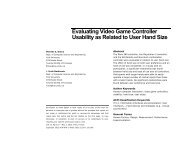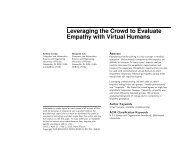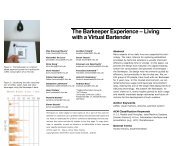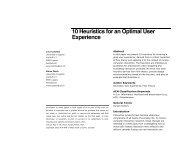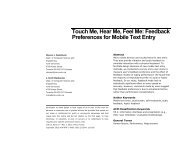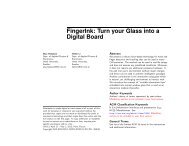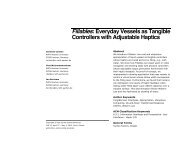Neurodiversity & HCI - alt.chi 2013
Neurodiversity & HCI - alt.chi 2013
Neurodiversity & HCI - alt.chi 2013
Create successful ePaper yourself
Turn your PDF publications into a flip-book with our unique Google optimized e-Paper software.
So long as you don’t type outside<br />
the right margin, it’s okay to put<br />
annotations over here on the right,<br />
too. Remember to use the<br />
annotation text style.<br />
Steve Silberman[27] reports on the high levels of<br />
autism and Asperger’s syndrome in Silicon Valley<br />
suggesting a link between that and the high tech<br />
computing industry there. Silberman even identifies<br />
some of the qualities of famous IT professionals such as<br />
Bill Gates as being parallel to such conditions.<br />
Attwood[3] [4] also reported high numbers of people<br />
with Asperger’s amongst IT professionals.<br />
In terms of computation and interaction there are a<br />
higher proportion of dyslexics in the software<br />
community. [29] Reports Approximately 30% of<br />
dyslexic undergraduates study scientific, engineering or<br />
medical disciplines. Pure programming is a good<br />
example of an intellectual activity which currently fails<br />
to discriminate against dyslexics. Powell suggests that<br />
the positive aspects of dyslexia (good overview, visual<br />
thinking, creativity) can be of help. ‘Programming is an<br />
arena where dyslexics can really flourish’[25].<br />
In [24] O’Keefe suggests that dyslexia was called the<br />
‘MIT disease’ because both Nicolas Negroponte and<br />
many of the researchers at the Media Lab were<br />
themselves dyslexic. Many dyslexics move into<br />
intellectual domains that can take advantage of high<br />
visual ability and strong creative passion which is<br />
typical of the visual arts. [30] Reports that 5.59% of<br />
UK Creative Arts and Design where dyslexic compared<br />
to 1.9% for all UK undergraduates and 4-10% for the<br />
general population. One study reported by<br />
Armstrong[2] identified 75% of fine art students at one<br />
of the top art schools in the UK as being dyslexic. This<br />
suggests that those in the area of interaction design<br />
may have a higher tendency for dyslexia.<br />
If this rate is reflected in interaction design, it is more<br />
surprising that neurodiversity has not emerged as an<br />
issue already. From this we might conclude while<br />
neurodiversity is an invisible disability, it also forms ‘an<br />
invisible community’ or at least a self-unaware<br />
community with in the <strong>HCI</strong> community. This part of the<br />
vision of neurodiversity <strong>HCI</strong> is to recognize and<br />
research the effects that <strong>Neurodiversity</strong> has potentially<br />
had already. Does creating a neurodiversity framework<br />
create a new kind of ontology about <strong>HCI</strong> and change<br />
the way we reflect upon our selves and our methods of<br />
practice? We believe that using neurodiversity as a<br />
banner under which this kind of work can be articulated<br />
will provide fresh insights into the practice of <strong>HCI</strong>.<br />
Challenges for <strong>HCI</strong> research practice<br />
As digital technologies become a greater part of our<br />
every day lives, they become vital aspects of our ability<br />
to both exploit society’s resources to live and<br />
importantly deliver value and employment in the larger<br />
economy. So on the one hand, interaction technology<br />
has the potential to further disenfran<strong>chi</strong>se and further<br />
marginalize the neurodiverse. On the other hand, we<br />
have seen that there are a large number of untapped<br />
gifts which the neurodiverse possess. By creating<br />
technologies to help exploit these gifts <strong>HCI</strong> has the<br />
opportunity to develop new we<strong>alt</strong>h creating potential in<br />
the neurodiverse and for the betterment of all.<br />
Further, if research is undertaken which can exploit<br />
aspects of giftedness in the neurodiverse, we can see<br />
from the spectrum argument that there are many in<br />
the neurotypical community that may be able to find<br />
advantage from this research. <strong>HCI</strong> research is a<br />
discipline which is strongly tied to and highly influential<br />
on the development of new interaction technologies.<br />
Therefore, it is natural for the neurodiverse to be able<br />
to raise its voice in this community. It is this voice<br />
which neurodiversity <strong>HCI</strong> tries to articulate. As



